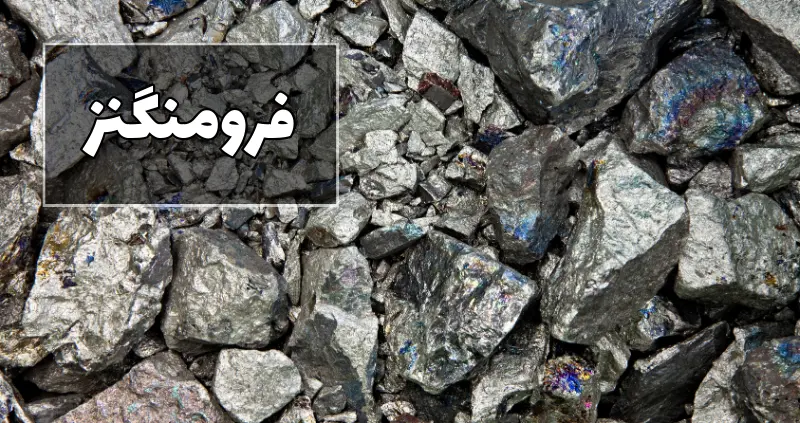
In the world of chemical and metallurgical industries, one of the key elements that plays a vital role is manganese. This unique compound not only plays a central role in steel production, but also has a wide range of industrial, agricultural, and even medical applications. From improving the mechanical properties of steels to soil and water remediation, manganese is always actively present behind the scenes. With all this, environmental challenges and resource constraints have made the development of this industry face complex issues. In this article, we will explore various aspects of manganese, from extraction and processing to its key applications and future developments.
Extraction and processing of manganese
Ferromanganese is extracted from mineral mines as one of the most important metal alloys. The main sources of this mineral are located in countries such as South Africa, Australia, China, and India. The process of extracting manganese from mines involves various stages, starting with drilling and extracting the raw material.
After extraction, the preprocessing and cleansing stage begins. At this stage, the minerals are cleaned from impurities and accompanying materials in preparation for subsequent processes. Techniques such as crushing, alkali leaching, and magnetic separation are employed in this process.
After preparing the raw material, the melting and production of ferromanganese begins. In this process, the cleaned mineral stones are melted in special furnaces to produce purer ferromanganese. Various techniques such as thermal and electrical revival are employed at this stage.
The processing of manganese ore does not reach this stage. After producing pure ferromanganese, quality analysis and control are carried out, and any possible impurities remaining are also removed. At this stage, ferromanganese is made available to consumers in its final product form with the required technical specifications.
The development of methods for extracting and processing manganese is continuously advancing. The use of innovative technologies and environmentally friendly approaches to increase productivity and reduce environmental impacts is among the key challenges in this industry.
Applications of manganese
Due to its unique properties, manganese has a wide range of applications in various industries. One of the most important and widely used applications is in the steel industry. Adding ferromanganese to pig iron improves mechanical strength, hardness and reduces brittleness of steel. These features make steel suitable for use in automotive, machinery, building structures and many other industries.
In addition to the steel industry, ferromanganese is also widely used in the chemical industry. This substance is used as a catalyst in the production of some chemicals such as potassium permanganate. It also has important applications in the paint industry and battery production.
Ferromanganese also plays an important role in agriculture. This substance is used as a fertilizer and soil additive to improve plant growth and increase yield. It is also used in aquaculture to increase the health and growth of aquatic organisms.
Another interesting application of ferromanganese is in the field of environment. This substance is used in water and soil purification and recycling processes to remove pollutants and improve the quality of the environment.
Ferromanganese also has important applications in the field of medicine. This substance is used as a disinfectant and also in the production of some medicines and food supplements. It is also used in the treatment of some diseases such as anemia.
Challenges and development
Despite the wide applications of ferromanganese in various industries, this industry also faces important challenges. One of the most important challenges is the limitation of ferromanganese mineral resources. As demand for the substance increases worldwide, there are concerns about the adequacy of supplies.
Also, the environmental issues caused by the extraction and processing of ferromanganese is another important challenge of this industry. Ferromanganese extraction and smelting processes are usually associated with the production of greenhouse gases and industrial waste, which can have negative effects on the environment. This has caused special attention to be paid to the development of cleaner and environmentally friendly methods in this industry.
In addition to the above, technical and technological challenges are also other issues facing the ferromanganese industry. Improving extraction methods, increasing the efficiency of production processes and developing new applications of ferromanganese requires continuous advances in technology and new technologies.
In order to overcome these challenges, experts and researchers are developing and applying innovative solutions. The use of advanced technologies in the extraction and production processes, optimization of energy consumption and waste recycling are among the important measures in this field.
Also, identifying and developing new applications of ferromanganese in different industries is another important solution to overcome existing challenges. This not only increases the demand and economic value of this material, but also provides the basis for innovation and technological advances in this field.
Ferromanganese management and supply chain
As a strategic mineral, ferromanganese plays an important role in the supply chain of various industries. The effective management of the supply chain of this material is very important.
In terms of supply and supply, ferromanganese is mainly supplied from a few limited countries such as South Africa, Australia and China. This issue has increased the dependence of consumer countries on these limited resources and raised the risks of the supply chain. Therefore, the identification and development of new and more diverse sources of ferromanganese supply is one of the important priorities in this field.
There are also challenges in the field of ferromanganese storage and transportation. The special characteristics of this mineral, including high viscosity and tendency to evaporate, require special equipment and methods of transportation and storage. It is important to develop and improve these methods to increase the efficiency and safety of ferromanganese supply chain.
Also, inventory management and ferromanganese supply and demand control at the global level are other important challenges in this field. Price fluctuations and sudden changes in demand have made it difficult to manage inventory and regulate supply flow. The use of advanced supply chain management techniques is particularly important to deal with these challenges.
Finally, cooperation and coordination among the various stakeholders of the ferromanganese supply chain, including producers, distributors, and consumers, is another key need in this area. This will increase flexibility, reduce costs and improve the overall efficiency of the supply chain.
Know more: Bullet nickel
final word
As a strategic mineral, ferromanganese plays a vital and extensive role in various industries. From improving the mechanical properties of steels to agricultural, environmental and medical applications, ferromanganese has always supported human development and progress. However, the challenges facing this industry, including resource limitations, environmental issues, and the complexities of supply chain management, have highlighted the need for innovation and initiative more than ever.
Innovative solutions in the field of extraction and processing of ferromanganese, development of new applications and improvement of supply chain management of this mineral will be the way to overcome these challenges. By taking advantage of scientific and technological advances and cooperation between different stakeholders, we can expect that the ferromanganese industry will become one of the pillars of sustainable and responsible development at the global level in the not too distant future.
